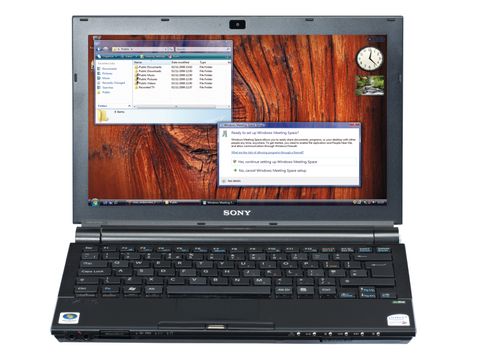TechRadar Verdict
Sony has chosen to stick with the tried and tested, and it's a sensible choice... for now
Pros
- +
Attractive and sleek
Good performance
Impressive battery life
Cons
- -
Dated components
Why you can trust TechRadar
This is the year that flash memory, in its various guises, will invade notebook storage. First Intel's Turbo Memory - using Vista's ReadyBoost and ReadyDrive features - followed by hybrid hard drives (HHDs) with small flash caches and, when prices drop, solid state drives (SSDs).
These storage saviours are meant to rescue mobile users from pure opto-mechanical drives that pump out heat, guzzle battery life and doggedly stifle performance. Sony, though, has flatly ignored flash memory with all of its new Vaio laptops, including this VGN-TZ11XN/B, more succinctly known as the TZ11.
In fact, Sony has sidelined a number of recent developments, including Santa Rosa (or Centrino 4, but officially Centrino Pro and Duo - Pro has security features). Instead, it's opted for a 'refreshed' Centrino 3 - or Napa - platform and the Mobile Intel 945GMS Express Chipset.
On face value, you may be wondering what's so great about paying £1,800 for last year's technology. The crux of the matter is that, currently, Intel's Santa Rosa platform isn't the best fit for an ultraportable.
Robbed of Robson
One reason for adopting the new Santa Rosa platform is to increase battery life and generate faster startup times through Intel's optional Turbo Memory. This uses flash modules of 512MB or 1GB housed in a mini-PCI slot to cache often accessed files that would normally be retrieved by a battery-sapping hard drive. The trouble is, Sony is adamant that both Turbo Memory and HHDs don't work with the first release of Vista.
Sony says that Vista's ReadyBoost and ReadyDrive features need to learn what to load into Turbo Memory or onto a HHD to increase performance and says the OS won't acquire that knowledge until SP1 arrives. It's also in no hurry to redesign its mainboard to fit in a mini-PCI module.
Our previous tests suggest that Turbo Memory offers a huge improvement as more data is cached, but Sony has snubbed flash memory and looked elsewhere to improve mobile efficiency.
The TZ11 may have lost out on Turbo Memory's claimed 20-minute boost to battery life, but 'refreshed' Napa support for the Intel Core 2 Duo means Sony has been able to plumb straight for the ultra low voltage chips (in this case running at 1.06GHz), which have a TDP (Thermal Design Power) rating of only 10W.
This Intel chip sports the far more aggressive Enhanced SpeedStep, which automatically switches between maximum performance mode and battery-optimised mode, depending on the application being run at the time. Sony has certainly worked out the angles to achieve the battery life result we got; it clocked close to four hours under processor-intensive conditions and over five hours in the default Vaio battery mode.
We were surprised, though, that Sony didn't cherry-pick Santa Rosa's Wi-Fi Link (4965AGN), since the Napa platform supports it now. However, Napa's Intel Pro/Wireless 3945ABG is adequate to most needs, covering 802.11a/b/g standards at 2.4GHz and 5GHz bandwidths.
In terms of graphics, Sony has again gone the way of Napa, using the Intel Graphics Media Accelerator 950. Its Cinebench results are adequate (306) and good enough to show off Vista's Aero niceties. Admittedly, we've already seen that the GMA X3100 graphics chipset would have doubled the TZ11's performance, adding T&L support, but is there really much point playing Doom 3 at 10fps?
Externally, this ultraportable has intelligent effort etched all over its aesthetically beautiful matte-black design. Even with the battery slotted into place across the hinge, it's a sleek number.
It weighs less than a kilogram in hand, while the 11.1in X-black screen, which will support hi-def at 720p, is only 5mm deep. In fact, the whole machine is a fraction under 30mm thick when the lid's closed. The Vaio's keyboard design has also undergone a stylish MacBook Pro-inspired redesign, making the keys nice and responsive.
The TZ11 is no feature slouch either: it comes with a DVD burner, webcam, biometrics security, 100GB hard drive and a Vista-satisfying 2GBs of memory. Sony's decision to offer real performance and battery life now, rather than risk it on an unproven spec is admirable, although it may just become the swan song for magnetic media storage in ultraportables.

